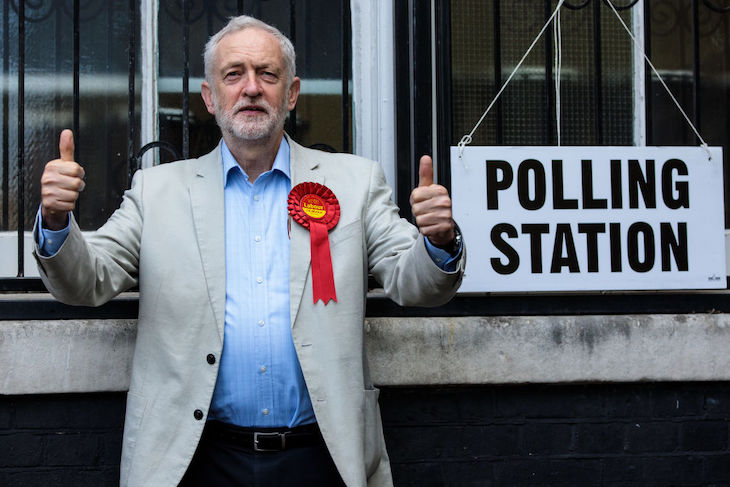The current obsession with Boris Johnson’s decision to marginally reduce Parliament’s sittings days has had the side effect of taking the spotlight off the tricky strategic decisions Jeremy Corbyn faces over the next two months.
Up until now, Corbyn has been content to continue attacking the prospect of no deal largely on the basis of the threat to workers’ jobs. The sight of him lining up on the same side as the big business forces of Remain is somewhat incongruous, whilst his description of no deal as a ‘bankers’ Brexit’ looks odd given how much funding Morgan Stanley, Goldman Sachs and the other international banks gave to the Remain campaign during the referendum.
Although it is reasonable to doubt the sincerity of the long-standing Eurosceptic’s opposition to no deal, Corbyn’s stance is perhaps easier to understand in the context of his equally long-standing anti-Americanism – combined with the generally-held view that no deal will inevitably be followed by closer ties to the US. In fact, although a clean break from the EU makes a US trade deal more attractive to the UK, such a deal would probably need the approval of MPs, which is an unlikely prospect given the current Parliamentary arithmetic.
In truth, it would be a stretch to argue that Corbyn’s Brexit strategy up to now has been driven solely by principle and that is unlikely to change going forward. So it is worth thinking about the choices he will have to make, and how they are likely to affect his electoral prospects.
A standard approach to identifying the best strategic choice in a dynamic situation like the one currently facing Corbyn is to use ‘backward induction’: look at the payoffs in the final stage of the ‘game’ and work backwards from there. The effective end-point in this case is the next general election, which one-way-or-another will surely take place within months. We can think of three distinct scenarios: a pre-Brexit election; an election after a no-deal Brexit; an election after a Brexit under a revised Withdrawal Agreement. Let’s take each in turn.
A pre-Brexit election
This outcome could happen either by MPs being successful in imposing a new PM as part of a ‘Government of Remainers’ or, else, instigated by Boris Johnson himself in the event of MPs being successful in taking control of the order paper with the aim of passing legislation to revoke or delay Article 50. It is the option favoured by many Labour MPs and activists but it could be the worst outcome for Labour’s electoral chances. Brexit party candidates would sweep up votes in Leave-leaning constituencies, whilst in remain-heavy areas, Labour would be vulnerable to the real-deal-Remain coalition of Greens and Lib Dems. It is not unrealistic to imagine Labour ending up with fewer than 150 MPs and that would surely be the end of the Corbyn leadership.
Corbyn’s main hope in this scenario is for the Conservatives to stand on a platform of a revised Withdrawal Agreement rather than no deal. The Brexit party would then provide an equal challenge to the Tories with unpredictable results. Even if Corbyn were somehow to emerge as PM, he would face continued civil war in the party over his next Brexit steps whilst EU state-aid and other regulations would severely limit his ability to implement his economic agenda.
An election after a no-deal Brexit
In this case, the Brexit party’s assault on Labour’s heartlands will be neutered and, although Boris would be seen by ardent Brexiteers as a hero, many voters (perhaps the majority) will simply breathe a sigh of relief that Brexit has been ‘dealt with’ and look to move on. Voters will perhaps even take a favourable look at some of Labour’s populist economic proposals, freed from restrictive EU rules. If the election takes place in the context of short-term no-deal disruption, the Tories can be blamed. As long as Corbyn can resist anything foolish like the party campaigning on a ticket immediately to re-join the EU, this is perhaps the best outcome for Labour’s electoral chances.
An election after a revised Withdrawal Agreement has been passed
This is a harder outcome to evaluate for Labour. Given how much Brexiteers hate the Withdrawal Agreement, Boris would be vulnerable to a Brexit party onslaught and Labour might well benefit from the Leave vote splitting. On the other hand, the WA could only be passed with the help of Labour MPs. Corbyn would then be vulnerable to the charge from Lib Dems and Greens that he allowed Brexit to happen.
Of these three outcomes, the only one which is unambiguously bad for Labour is fighting an election in the middle of another Brexit delay. Internal party dynamics mean that Jeremy Corbyn has little option but to back Parliamentary manoeuvres to eliminate a no-deal Brexit. But given that ruling out no deal inevitably means no Brexit at all, Corbyn may well enter the Parliamentary battles next week with somewhat less than overwhelming enthusiasm.
The most interesting decision he may face, will come if the Remain forces fail to rule out no deal and Boris comes back in October with a revised Withdrawal Agreement. The dominance of Remain MPs in Labour mean he is highly unlikely to back any deal formally, but it is just possible that Corbyn will turn enough of a blind eye for Labour MPs to back the revised deal (or abstain) in sufficient numbers for it to pass. Passing a revised Withdrawal Agreement is (perversely) the worst of all outcomes for Boris Johnson, a factor that might well be in the back of Jeremy Corbyn’s mind during the Parliamentary battles this week.
David Paton is professor of industrial economics at Nottingham University Business School. He tweets at @cricketwyvern






Comments